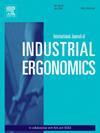光噪声水平和任务类型对飞行员视觉认知负荷的影响
IF 3
2区 工程技术
Q2 ENGINEERING, INDUSTRIAL
International Journal of Industrial Ergonomics
Pub Date : 2025-04-24
DOI:10.1016/j.ergon.2025.103747
引用次数: 0
摘要
许多环境因素会影响飞行员在飞行过程中的认知负荷。本研究旨在调查光线、噪音和任务类型对执行驾驶舱平视显示器(HUD)任务的飞行员视觉认知负荷的影响。研究人员招募了20名参与者进行眼动追踪实验和脑电图(EEG)实验。在实验过程中,参与者在三个光照水平(1、100和200 lx)和三个噪声水平(55、85和100 dB(A))下完成了两项任务(静态搜索和动态飞行)。记录任务准确性、任务时间、七次眼球运动以及EEG事件相关电位N2和P3分量的平均振幅。相关性分析用于研究视觉认知负荷与EEG波动之间的关系。结果显示,参与者的表现在200 lx的光照水平和100 dB(a)的噪音水平下受到损害。在100 lx的光照和55 dB(a)的噪声水平下,他们的认知效率最高。动态飞行任务的认知负荷高于静态搜索。本文章由计算机程序翻译,如有差异,请以英文原文为准。
The effects of light and noise levels and task types on the visual cognitive load of pilots
Many environmental factors affect the cognitive load of pilots during flights. The purpose of this study was to investigate the effects of light, noise, and task type on the visual cognitive load of pilots performing cockpit head-up display (HUD) tasks. The researchers recruited 20 participants for eye-tracking experiments and electroencephalography (EEG) experiments. During the experiments, participants completed two tasks (static search and dynamic flight) under three light levels (1, 100, and 200 lx) and three noise levels (55, 85, and 100 dB(A)). The task accuracy, task time, seven eye movements, and the mean amplitudes of the N2 and P3 components of the EEG event-related potentials were recorded. Correlation analysis was used to investigate the relationship between the visual cognitive load and the EEG fluctuations. The results showed that the participants' performance was impaired at a light level of 200 lx and a noise level of 100 dB(A). Their cognitive efficiency was the highest at a light level of 100 lx and a noise level of 55 dB(A). The cognitive load was higher during the dynamic flight task than during the static search.
求助全文
通过发布文献求助,成功后即可免费获取论文全文。
去求助
来源期刊
CiteScore
6.40
自引率
12.90%
发文量
110
审稿时长
56 days
期刊介绍:
The journal publishes original contributions that add to our understanding of the role of humans in today systems and the interactions thereof with various system components. The journal typically covers the following areas: industrial and occupational ergonomics, design of systems, tools and equipment, human performance measurement and modeling, human productivity, humans in technologically complex systems, and safety. The focus of the articles includes basic theoretical advances, applications, case studies, new methodologies and procedures; and empirical studies.

 求助内容:
求助内容: 应助结果提醒方式:
应助结果提醒方式:


